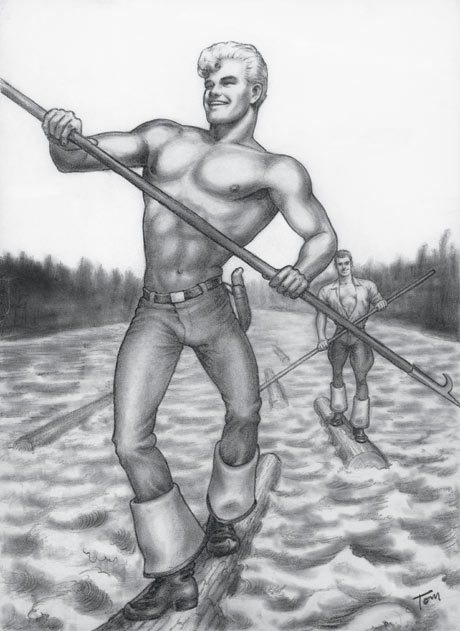The belated homecoming of Tom of Finland
-

The man who invented the macho gay image could be the hero of 2011's European city of culture.
* Alfred Hickling
* guardian.co.uk, Wednesday 19 January 2011 21.59 GMTFinland's cultural gifts to the world include Sibelius, the Moomins and an artist that the country has been less eager to celebrate. The name Touko Laaksonen may not be immediately familiar; and unless you are acquainted with homoerotic art, his alter ego Tom of Finland may not mean much either. But you have almost certainly seen the style he created: a pantheon of bikers, leather-men, lumberjacks and rodeo stars that defined the macho-gay image of the 1970s.
Born in 1920, Tom came from Turku, this year's European Capital of Culture. Only the fifth-largest city in Finland, Turku has a well-preserved castle, the country's oldest cathedral and a museum containing Sibelius's final, half-smoked cigar. But it is hardly so culture-rich as to be able to ignore the region's most internationally recognised artist.
A self-taught draughtsman, Laaksonen's earliest homoerotic drawings were inspired by his service in the Finnish armed forces. After the war, he worked in advertising, but another career arrived in 1956 when the American publication Physique Pictorial – a bodybuilding magazine serving a predominately gay audience – published Laaksonen's drawing of an Adonis-like lumberjack on the cover. The editors credited the work to "Tom of Finland", a pseudonym Laaksonen was never entirely happy with, though American "beefcake" magazines became the major outlet for his work. In 1973, he was able to move to California and live exclusively from sales of erotic pictures.
Although the Museum of Modern Art in New York contains examples of Tom's work, and he has been shown at the Venice Biennale, the Finns have been slow to embrace him. This may not seem so surprising given that homosexuality was illegal in Finland until 1971, and same-sex partnerships were sanctioned only in 2002. Even today, the country isn't noted for tolerance: last July, a gay pride march in Helsinki became the target of a gas attack.
The artistic director of Turku 2011, Suvi Innilä, admits that showing Tom was a controversial choice. "At first, I was not sure if you could include such images in a mainstream arts festival," she says. "But then when I saw the quality of the original drawings on paper, there could be no doubt. He is, without question, the most significant and influential artist to come from this region. The idea of having a cultural year in Turku without him was unthinkable."
Tom's homecoming has been facilitated by the Liverpool-based arts organisation Homotopia, which mounted the first UK showing of his work, and expanded with contributions from the Tom of Finland Foundation in LA. Although Tom published his work in America, the illustrations explore a distinctively Scandinavian milieu – the Finnish cultural cornerstones of the sauna and the sausage stand feature prominently. Yet despite the explicit content of some of the images, this retrospective has not been hidden under the counter. It runs for a full year at Logomo, a new space that forms the focal point of the Turku 2011 celebrations. More than 50,000 people are expected to visit; in the experience of curator Gary Everett, fewer than half of them are likely to be gay.
"When we first showed Tom in Liverpool, 55% of the audience were straight women," Everett says. "I think Tom can be quite liberating for women because it gives them the chance to see men objectified in a way that women have been objectified for centuries."
So is it art or is it porn? Durk Dehner, founder of the Tom of Finland Foundation and a close friend of the artist, insists it can be both. "Tom is a unique case in that he is simultaneously found in mainstream galleries and adult bookstores. The vast majority of his output was masturbatory material to be kept under the bed, yet it also comes packaged in coffee-table volumes for open display."
The drawings in the exhibition are modest in scale and mostly executed in pencil. They show Laaksonen to be a naturally gifted draughtsman who deliberately limited his range. Yet he arrived at a style that was instantly recognisable. Simply put, without Tom of Finland, there would have been no Village People.
"Tom created a kind of sexual Valhalla of Scandinavian gods which became a fantasy boot camp for the founders of the gay rights movement," Dehner says. "Before Tom, gay men were seen as effeminate sissies. He was the first person to show gay men as macho, proud and assertive."
Towards the end of Tom's life, the drawings took on a darker hue: the sex becomes more joyless and a new addition appeared – the condom. "There's a deep sorrow in the later pieces," Dehner says. "After the spread of Aids, Tom experienced a huge burden of guilt. He had given people confidence to go out and explore their sexuality and he began to wonder if he was partly responsible for sending all those young men to their deaths."
Yet 20 years after his death, the artist's influence seems stronger than ever. "If you've ever bought a pair of Calvin Klein briefs, looked at a Levi's ad or seen Freddie Mercury perform, you've experienced Tom of Finland," Dehner says. "He's unavoidable. In a sense, we are all Tom's men now."